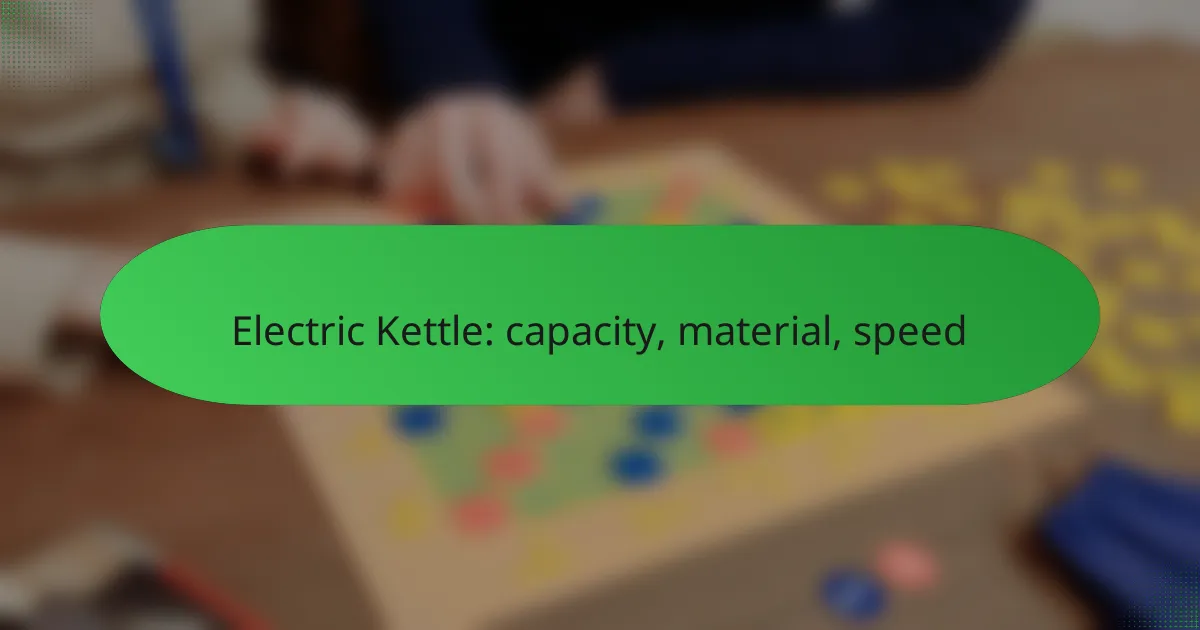Electric kettles are a convenient kitchen appliance, typically available in capacities ranging from 1.5 to 2.0 litres, suitable for both individual and family use. They are commonly made from materials like stainless steel, glass, or plastic, each offering unique benefits in terms of durability and heat retention. With the ability to boil water in just a few minutes, electric kettles are an efficient choice for preparing hot beverages and meals.
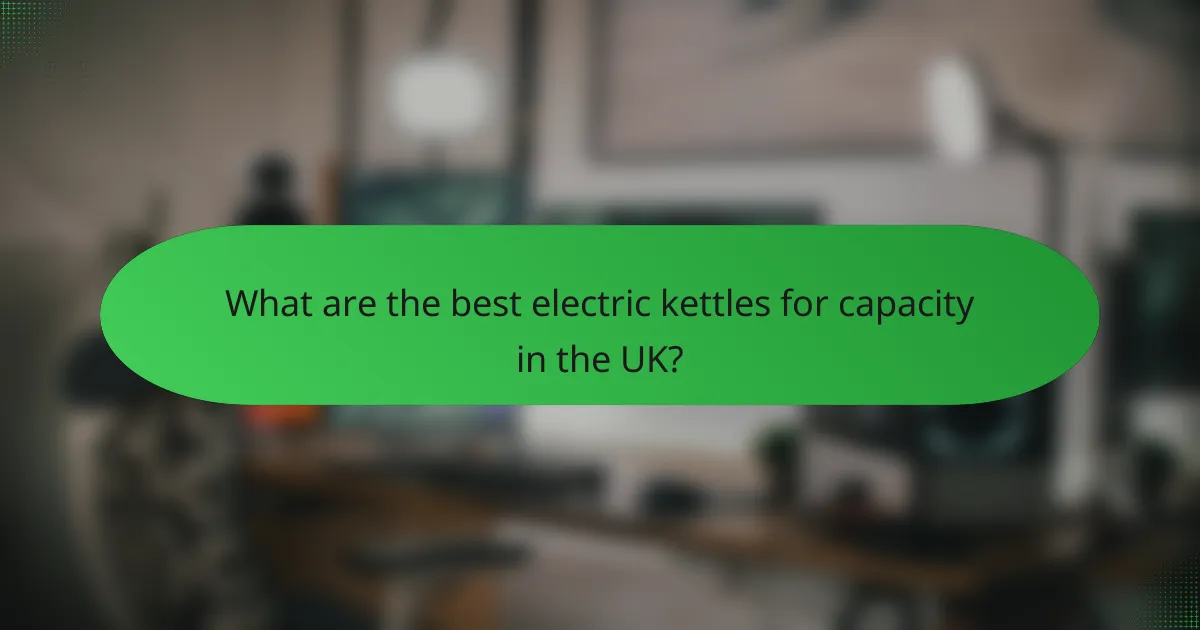
What are the best electric kettles for capacity in the UK?
In the UK, the best electric kettles for capacity typically range from 1.5 to 2.0 litres, catering to various household needs. Choosing the right capacity depends on your daily usage, whether for a single cup or multiple servings at once.
1.7 Litres capacity kettles
Kettles with a capacity of 1.7 litres are ideal for medium-sized households, providing enough water for several cups of tea or coffee without being overly bulky. They usually boil water in a matter of minutes, making them efficient for daily use.
Popular models in this category often feature rapid boil technology and automatic shut-off for safety. When selecting a 1.7-litre kettle, consider the material, as stainless steel and glass options offer durability and aesthetic appeal.
2.0 Litres capacity kettles
For larger families or frequent entertaining, 2.0-litre electric kettles are a practical choice. They can easily accommodate multiple servings, reducing the need for multiple boils throughout the day.
These kettles often come with advanced features such as temperature control and keep-warm functions. However, they may take slightly longer to heat water compared to smaller models, so consider your speed preferences when making a selection.
Compact kettles under 1.5 Litres
Compact kettles under 1.5 litres are perfect for individuals or small households with limited kitchen space. They are lightweight and easy to store, making them a convenient option for those who only need to boil water for one or two cups at a time.
While they may not be suitable for larger gatherings, many compact models still offer quick boiling times and energy efficiency. Look for features like a removable filter and easy-pour spout to enhance usability in this smaller size category.
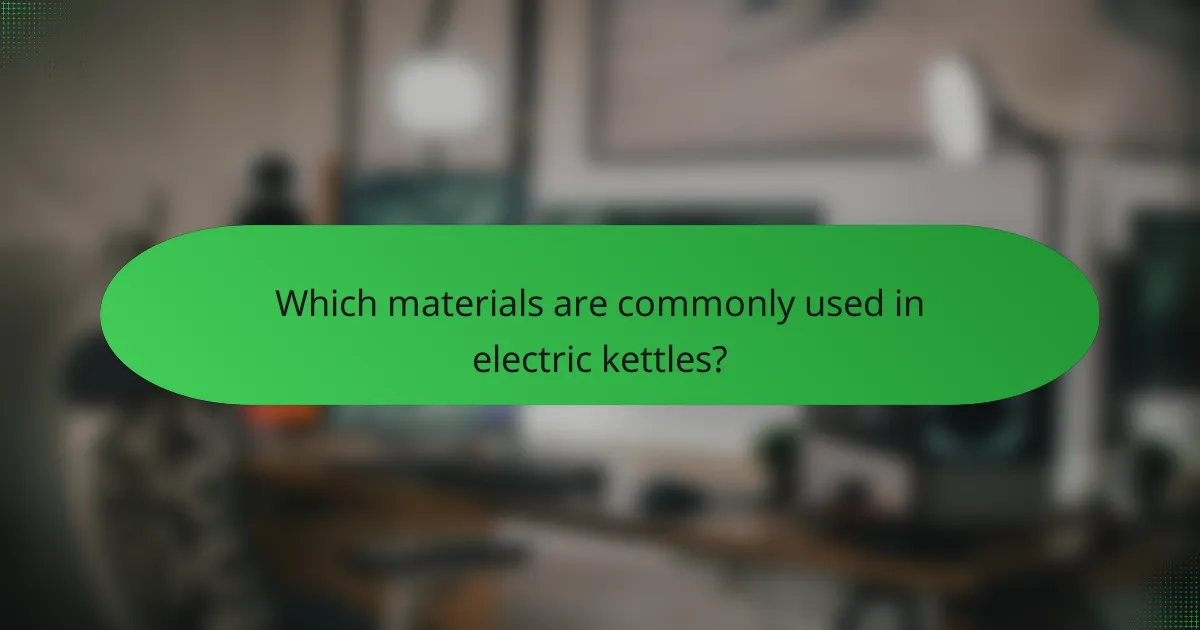
Which materials are commonly used in electric kettles?
Electric kettles are typically made from stainless steel, glass, or plastic, each offering distinct advantages and disadvantages. The choice of material affects durability, heat retention, and aesthetic appeal, making it important to consider personal preferences and usage needs.
Stainless steel electric kettles
Stainless steel electric kettles are known for their durability and resistance to rust and corrosion. They often feature a sleek design and can retain heat well, making them efficient for boiling water quickly.
When choosing a stainless steel kettle, look for models with a double-walled construction for better insulation. However, be aware that they can become hot to the touch, so check for cool-touch handles to avoid burns.
Glass electric kettles
Glass electric kettles provide a visually appealing option, allowing users to see the water as it boils. They are generally easy to clean and do not retain odors or flavors from previous uses.
While glass kettles can be stylish, they are more fragile than their stainless steel or plastic counterparts. It’s essential to handle them with care and ensure they have a sturdy base to prevent tipping.
Plastic electric kettles
Plastic electric kettles are often lightweight and budget-friendly, making them a popular choice for many households. They come in various colors and designs, catering to different aesthetic preferences.
However, it’s important to choose BPA-free plastic to avoid health concerns. Plastic kettles may not retain heat as well as metal or glass options, so consider how quickly you need your water to boil when selecting a model.
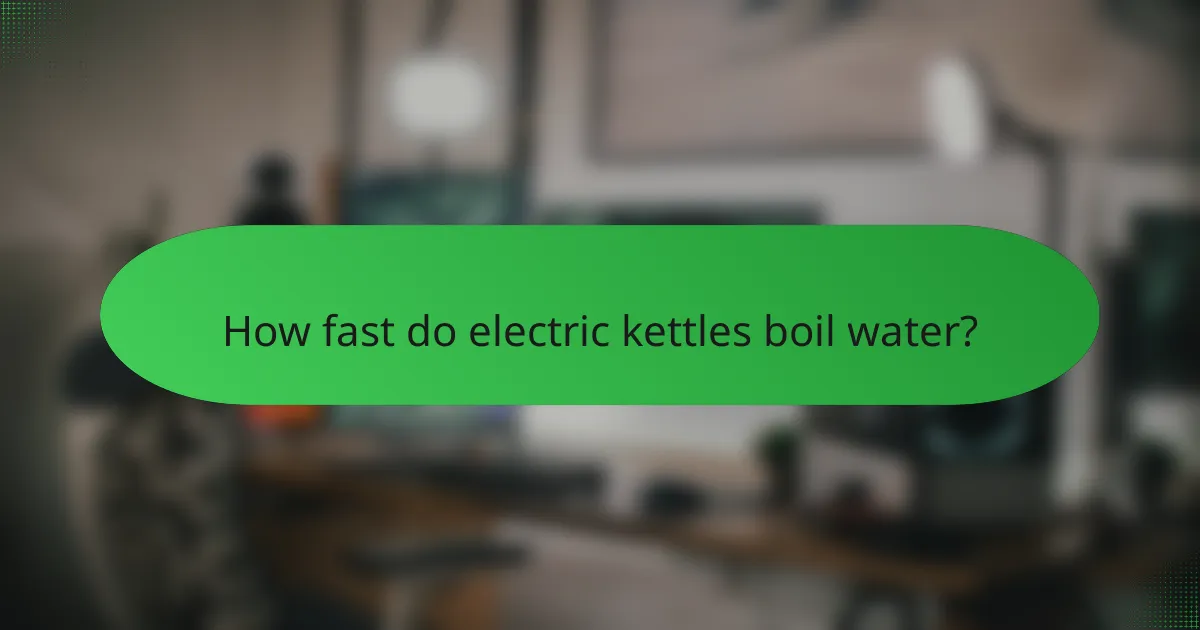
How fast do electric kettles boil water?
Electric kettles typically boil water quickly, often within a few minutes depending on their capacity and power. Most models can bring water to a boil in under ten minutes, making them a convenient choice for hot beverages and cooking.
Boiling time for 1 litre
For 1 litre of water, electric kettles generally take around 3 to 5 minutes to reach boiling point. The exact time can vary based on the kettle’s wattage, with higher wattage models boiling water faster.
For example, a kettle with a power rating of 2000 watts may boil 1 litre in closer to 3 minutes, while a lower wattage kettle might take up to 5 minutes.
Boiling time for 2 litres
When boiling 2 litres of water, the time increases to approximately 5 to 8 minutes. Again, this depends on the kettle’s wattage and efficiency.
A 2000-watt kettle may boil 2 litres in about 5 to 6 minutes, while a 1500-watt model could take around 8 minutes. It’s advisable to check the specifications of your kettle for more precise timings.
Factors affecting boiling speed
Other factors include the kettle’s design, such as the shape of the heating element and the material used, which can affect heat transfer efficiency. Regular maintenance, like descaling, can also ensure optimal performance and speed.
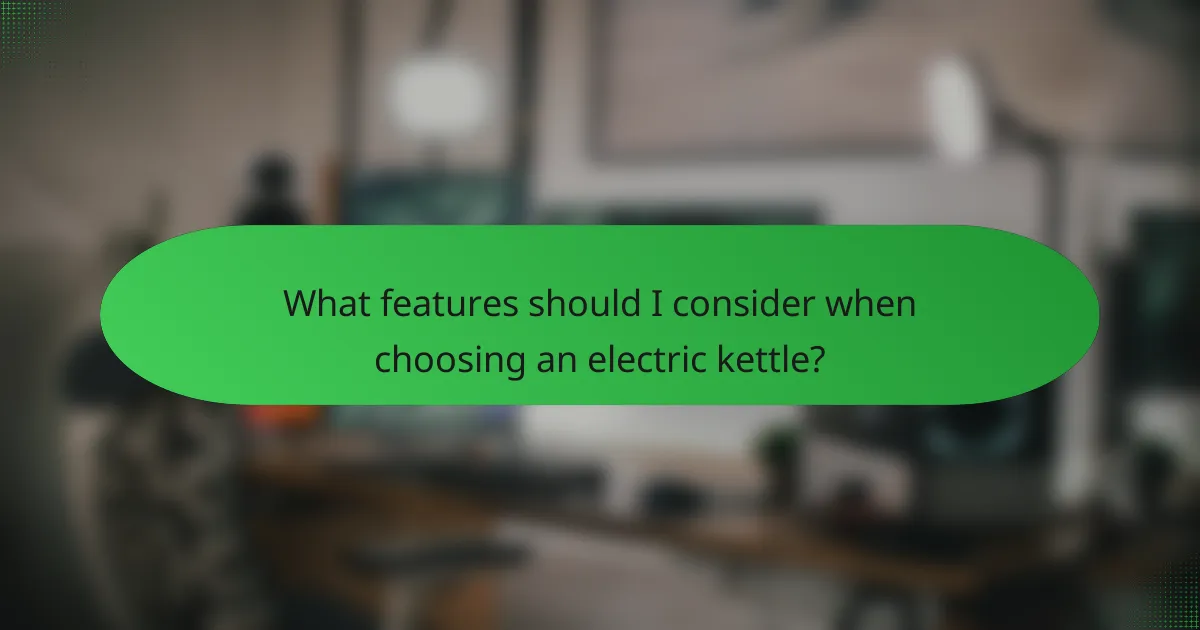
What features should I consider when choosing an electric kettle?
When selecting an electric kettle, consider features such as temperature control, safety mechanisms like auto shut-off, and energy efficiency ratings. These aspects will influence not only the performance but also the safety and cost-effectiveness of your kettle.
Temperature control options
Temperature control options allow you to set precise heating levels for different types of beverages. Many electric kettles offer preset temperatures, typically ranging from around 60°C to 100°C, which is ideal for brewing tea or coffee.
Some models feature variable temperature settings, enabling you to adjust the heat according to your preference. This is particularly useful for specialty teas or delicate brews that require specific temperatures for optimal flavor extraction.
Auto shut-off safety feature
The auto shut-off safety feature is crucial for preventing overheating and potential accidents. Most electric kettles automatically turn off once the water reaches boiling point, ensuring safe operation.
Look for kettles with additional safety features, such as boil-dry protection, which prevents the kettle from operating when there is insufficient water. This adds an extra layer of safety, especially in busy kitchens.
Energy efficiency ratings
Energy efficiency ratings indicate how much energy an electric kettle consumes during operation. Kettles with higher efficiency ratings can save you money on electricity bills over time.
When comparing models, consider kettles that heat water quickly, as they typically use less energy. A kettle that can boil water in under five minutes is generally considered efficient and practical for everyday use.
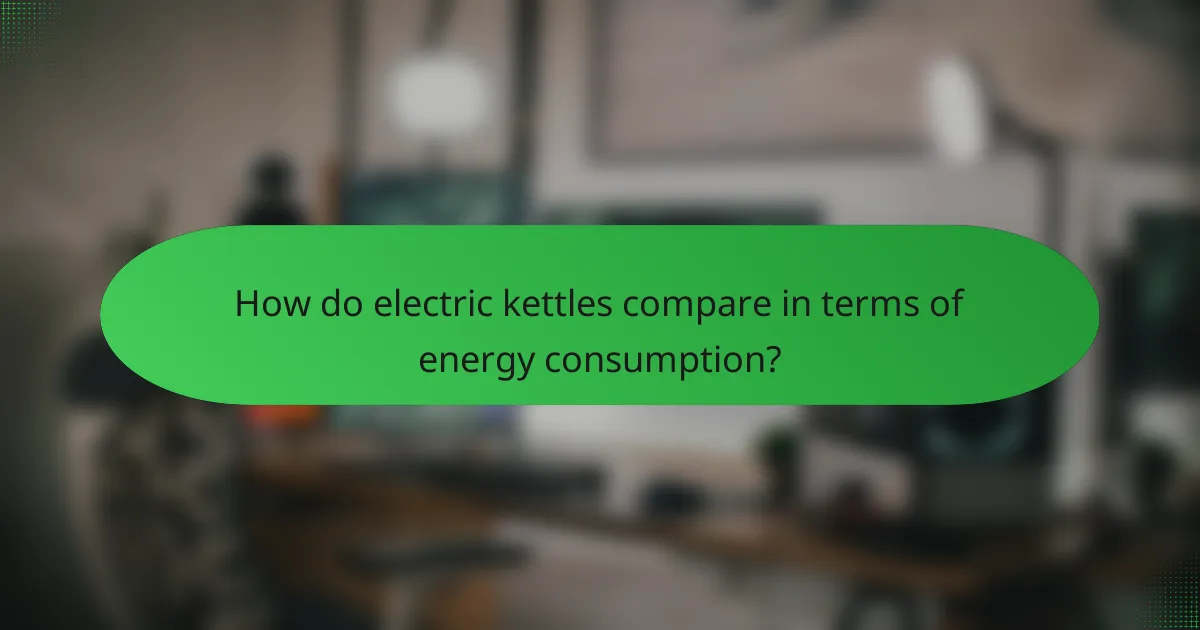
How do electric kettles compare in terms of energy consumption?
Electric kettles are generally more energy-efficient than traditional stovetop kettles, using less electricity to boil water. Their design allows for faster heating, which can lead to lower energy costs over time.
Energy usage per boil
The energy consumption of electric kettles typically ranges from about 1,500 to 3,000 watts, depending on the model and capacity. A standard kettle can boil water in approximately 5 to 10 minutes, consuming around 0.1 to 0.2 kWh per use.
In comparison, stovetop kettles may take longer and use more energy due to heat loss. To minimize energy use, only boil the amount of water you need.
Long-term cost savings
Using an electric kettle can lead to significant savings on your energy bill over time. Given their efficiency, they can reduce energy consumption by about 20-30% compared to other boiling methods.
For example, if you boil water daily, the savings can add up to several dollars a year. Consider investing in a kettle with an automatic shut-off feature to prevent unnecessary energy waste.
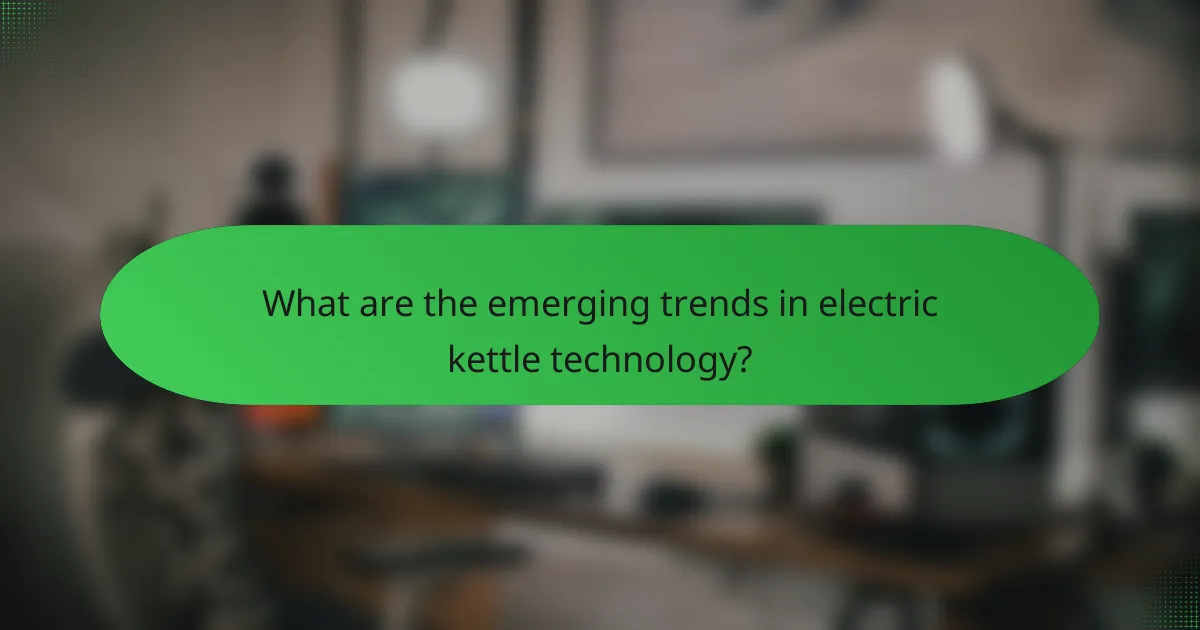
What are the emerging trends in electric kettle technology?
Emerging trends in electric kettle technology focus on efficiency, smart features, and advanced materials. Innovations aim to enhance user convenience, reduce energy consumption, and improve safety.
Capacity
Electric kettles now come in a variety of capacities, typically ranging from 0.5 liters to 2 liters. Smaller models are ideal for single servings or small households, while larger kettles cater to families or gatherings. Choosing the right capacity depends on your typical usage and the number of people you serve.
Material
Modern electric kettles are made from several materials, including stainless steel, glass, and plastic. Stainless steel offers durability and heat retention, while glass allows for visibility during boiling. Plastic kettles are often lighter and more affordable but may not retain heat as effectively.
Speed
Speed is a significant factor in electric kettle performance, with most models boiling water in under five minutes. High wattage kettles, typically around 1500 to 3000 watts, heat water faster. When selecting a kettle, consider how quickly you need hot water for your beverages or cooking needs.
